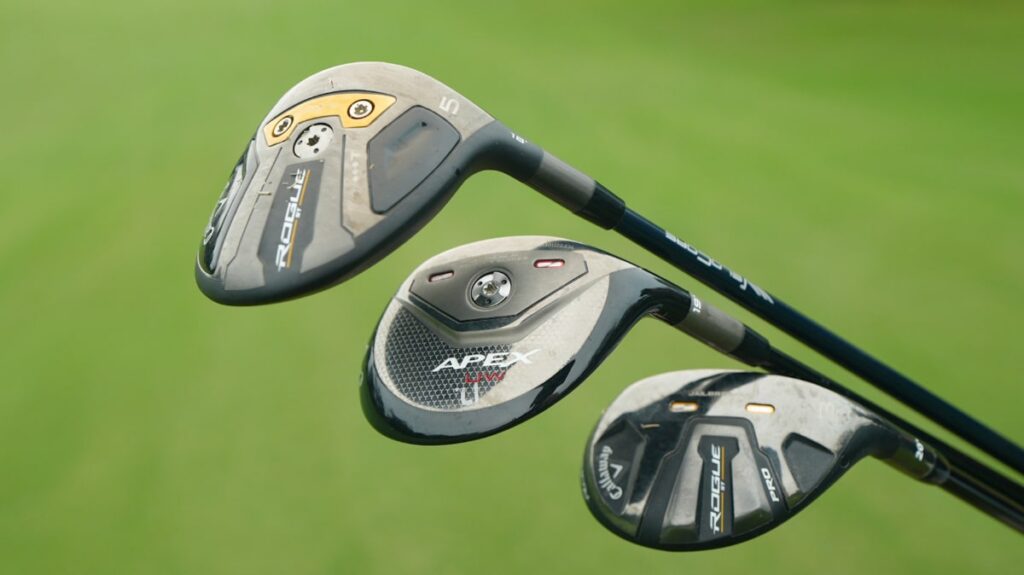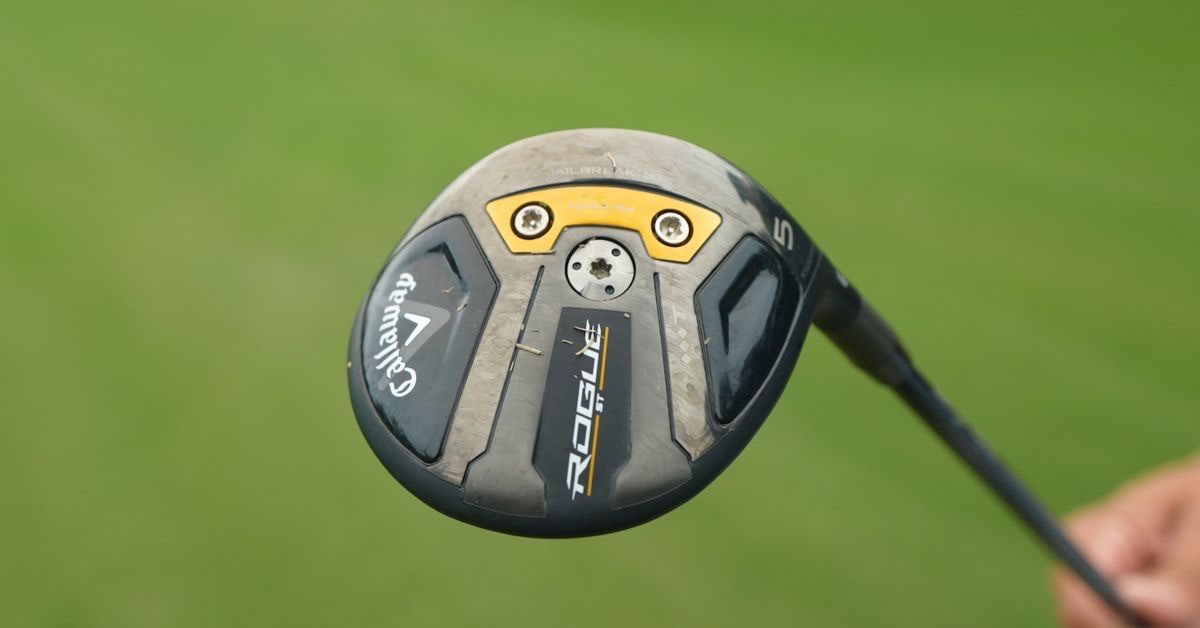Trying to pick your 14 clubs is an age-old nightmare for any golfer.
I’ve always found that choosing which fairway woods to use at the top end of the bag is the hardest decision of them all. In particular — what does a 5 wood replace?
In this article, I’ll take you through your options if you want a 5 wood in your bag, why a 5 wood is useful on the course, along with any alternatives.
By the end, you’ll know precisely whether or not a 5 wood is right for you.
So, let’s get into it!
What Is a 5 Wood?

5 woods are fairway woods built with around 18 degrees of loft. Generally, they’re used for long-distance shots of around 200 yards — either from the tee, fairway, or even the rough. They provide slightly more loft than 3 woods, to help get the ball airborne and landing more softly.
Woods — named after the material they used to be made from — are the clubs used to hit the ball the longest distances on the golf course.
They’re numbered from 1 to 9, with a 1 wood commonly known as the driver. As the numbers go up, the loft increases, and the overall carry distance goes down.
Depending on a wide variety of factors — including swing speed, club performance, and loft angle — a 5 wood will usually allow you to hit the ball 160 to 240 yards.
Those with slower swing speeds and higher handicaps are likely to be at the lower end of that scale, while pros can hit a 5 wood closer to 300 yards. For instance, Jon Rahm averaged 266 yards with his 5 wood at the 2022 PGA Championship.
The precise loft angle can change from one brand to another, but it generally sits at around 18 degrees. So what does this all mean for the golf course?
Typically, 5 woods are less commonly used for tee shots (aside from perhaps par 3’s) as the driver is more likely to be used for maximum distance.
Instead, the 5 wood is commonly used either on the fairway into par 4s or 5s or out of the rough when you still have plenty of distance to reach the pin.
Pros of a 5 Wood
- More forgiveness — easier to hit than long irons due to the head size and low CG
- Excellent versatility — can be used off the tee, fairway, or out of the rough
- Shorter shaft — easier to find the center of the clubface than with a 3 wood
Cons of a 5 Wood
- Not ideal in the wind — hard to keep under the wind due to the high launch angle
- Challenging out of deep rough — not enough loft to cut through thicker grass
What Does a 5 Wood Replace?

Ultimately, 5 woods are an ideal long iron replacement as they offer more forgiveness and versatility. Additionally, they can be used as a driver replacement for tee shots if you are struggling with your driver. Also, 5 woods can replace the 3 wood when you need a higher launching alternative.
Remember, you’re only allowed to carry 14 clubs — if you’re a stickler for the rules!
Golfers who opt to carry four wedges (pitching, gap, sand, and lob) often end up having a club selection headache of choosing between the 3 wood, 5 wood, 3 iron, and a hybrid for just two slots towards the top end of the bag.
The driver and putter take up two slots, four for the wedges, and most golfers want the 4 to 9 irons, which accounts for six clubs. That all adds up to 12, so there are two slots remaining for your fairway woods or hybrids.
So, if you’re to choose two clubs from the 3 wood, 5 wood, 3 iron, and a hybrid — which should you pick? Let’s take a look at some head-to-head comparisons.
5 Wood vs 3 Wood
When choosing between a 5 wood and a 3 wood, it often comes down to skill level.
I’ve always found the 5 wood to be more versatile than the 3 wood. Not only is it useful in a wide variety of situations, but the extra loft also makes it easier to hit.
Personally, I’d prefer to leave a wedge at home rather than go without a 5 wood.
Having said that, I have the benefit of a relatively high swing speed. This means that the shot distance gap between my driver and the 5 wood isn’t too big. Players with lower swing speeds may need the extra distance that you can get from a 3 wood.
5 Wood vs 3 Hybrid
Another great option at the top end of the bag is the 3 hybrid.
Many people love having a hybrid in their bag as it offers the power of a wood crossed with the control of an iron. Hybrids are numbered like the other types of club, and the closest direct comparison to a 5 wood is the 3 hybrid.
Both 5 woods and 3 hybrids offer similar levels of forgiveness and versatility on the course, so choosing between them generally comes down to personal preference.
Hybrids have a lower ball flight, which can be better for more penetrating shots that you keep under the wind. However, this can mean that it’s harder to hold greens with approach shots using a hybrid, as the ball is likely to roll off the back.
It’s fairly common for golfers to carry both a fairway wood and a hybrid for this reason.
5 Wood vs 3 Iron
In recent years, package iron sets have started at the 4 iron. This is because the 3 iron is generally considered an unforgiving club, and is difficult to hit consistently well.
Ultimately, the 5 wood offers plenty more forgiveness and versatility than the 3 iron.
In my mind, the 5 wood can perfectly replace the 3 iron in the everyday golfer’s bag.
That said, some players like the traditional aspect of carrying a 3 iron. It can be useful for flat, low-trajectory shots — but it requires lots of skill to pull this off.
How to Hit a Fairway Wood

If you’re thinking of adding a 5 wood to the bag, it’s important to consider the ideal technique for swinging a fairway wood for best results on the golf course.
In short, these are the four main steps to keep in mind:
- Don’t lean back
- Ball position forward
- Sweep the ground
- Don’t overswing
Let’s take a look at each step in some more detail.
1. Don’t Lean Back
One of the biggest mistakes beginners make with fairway woods is leaning back during the swing. Trust the natural loft on your club, and keep your head over the ball.
That way, you’ll be more likely to make clean contact with the ball without risking hitting too much turf first — or topping the ball.
2. Ball Position Forward
Stand with your feet together with the ball lined up directly between your feet.
For right-handers, take a small step with your left foot, and a much bigger one with your right. Having the ball forward in your stance will give you the best chance of striking the ball cleanly, allowing the clubface to meet the ball at the correct angle.
3. Sweep the Ground
With a fairway shot, you want the club to graze the turf — rather than take a divot.
You can easily practice this without a ball. Ideally, you’ll see and hear the slight sweeping of the turf when you make perfect contact with the ground.
4. Don’t Overswing
The beauty of using woods for your fairway shots is that they have the size and power for long shots. Because of this, you don’t need to swing too hard and lose accuracy.
Swing within yourself, and allow the length of the shaft and size of the club head to naturally transfer energy into the golf ball — rather than exerting too much force.
This will ensure you make solid contact, without risking a thin or fat shot.
Check out the video below by Swing Quest, which demonstrates these handy steps for hitting a fairway wood off a typically tight fairway lie:
Is a 5 Wood Right For Your Game?
Ultimately, the 5 wood is an excellent choice for the top end of your golf bag.
It offers more forgiveness than other clubs of similar loft, helping you achieve great long-range shots from the fairway while still maintaining shot accuracy.
For this reason, the 5 wood can replace several clubs such as the 3 iron or 3 wood.
As you develop your game, you may find that other clubs are better for your style, or offer better distance gap management between the driver and long irons.
But for those starting out, the 5 wood will be a valuable part of your set.


